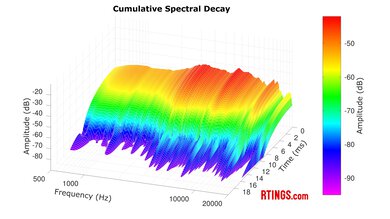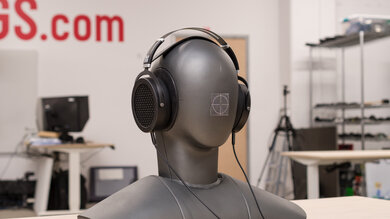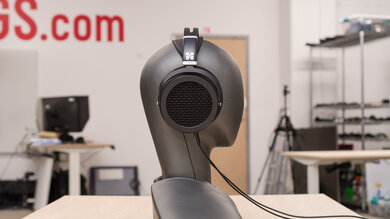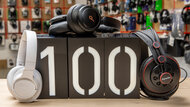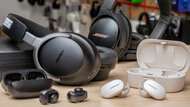The HiFiMan Sundara 2020 are open-back, planar magnetic headphones. They're the next generation of the HiFiMan Sundara 2018, and the manufacturer advertises a redesign of the ear cup padding. They're comfortable audiophile headphones that are best suited to listening at home due to their bulky design and lack of a carrying case. You can even drive them without an amp, making them a versatile set of headphones with a variety of devices.
Our Verdict
The HiFiMan Sundara 2020 are inadequate for sports and fitness. They're large, hefty over-ears that aren't designed for staying put during exercise. Their wired connection makes them inconvenient to navigate around equipment, and the open-back housings leak audio and don't isolate out environmental sounds either.
-
Well-built and comfortable.
-
No protective case or pouch and bulky in size.
-
Leak a lot of audio.
The HiFiMan Sundara 2020 are terrible for travel. Because the headphones are open-backed, they won't isolate you from fellow passengers and engine noises whatsoever. Plus, whatever you're listening to will leak out and bother people nearby. They're also rather large and don't fold down smaller. While they're comfortable to wear, they're meant to be worn in quiet spaces, not in public.
-
Well-built and comfortable.
-
Not designed to isolate you from passive noise.
-
No protective case or pouch and bulky in size.
-
Leak a lot of audio.
The HiFiMan Sundara 2020 are a bad choice for office work. Their open-back design means you'll disturb your coworkers with your audio escaping into the office space, and there's virtually zero isolation to block out environmental noises. They lack a mic, so you'll also need an outboard one for remote meetings. On the upside, they're comfortable and well-cushioned, but unless you have a private office and don't need a mic, they're not suited for offices.
-
Well-built and comfortable.
-
Not designed to isolate you from passive noise.
-
No microphone.
-
No protective case or pouch and bulky in size.
-
Leak a lot of audio.
The HiFiMan Sundara 2020 are wired-only headphones, so you can't use them for wireless gaming.
The HiFiMan Sundara 2020 are okay for wired gaming. If you don't need headphones with a microphone, these open-backs can connect to PCs and consoles without needing an amp. Their consistent sound and very comfortable fit are positives for gamers. The tuning is fairly flat, so you'll hear dialogue and soundtracks with clarity, though there aren't any additional tools to tweak the frequency response. Their open-back design means they can leak audio into the space and won't block much, which is fine in private rooms.
-
Well-built and comfortable.
-
Very consistent sound delivery.
-
No EQ or presets.
-
No microphone.
The HiFiMan Sundara 2020 are great for audio reproduction accuracy. Their flat sound signature supplies a bit of de-emphasis in the bass and treble for a slightly warm tonality with clear instrumentation in the mix and not too many peaks and dips. Overall, the drivers are well-matched and demonstrate very low distortion. They're also very consistent between wears and on people who wear glasses or have long hair. As open-backs, they offer a decent PRTF performance.
The HiFiMan Sundara 2020 are open-back headphones, so their noise isolation is terrible by design. They both leak a noticeable amount of your audio into the room and let nearly all of the environment's ambient sounds reach your ears.
The HiFiMan Sundara 2020 don't come with a microphone.
The HiFiMan Sundara 2020 have very good frequency response consistency. If you take the time to seat them properly with each wear, you'll get a consistent sound each time, even if you have longer hair or a larger head.
- 5.9 Sports And Fitness
- 4.5 Travel
- 3.0 Office Work
- 4.6 Wireless Gaming (In Development)
- 6.6 Wired Gaming (In Development)
Performance Usages
- 8.0 Audio Reproduction Accuracy
- 0.7 Noise Isolation
- 0 Microphone (In Development)
- 7.9 Frequency Response Consistency
Changelog
-
Updated Jul 29, 2025:
We've updated the Sound Profile box with a link to a downloadable folder of EQ settings that will help you match these headphones' frequency response to different target curves available in our Graph Tool.
-
Updated Apr 25, 2025:
This review has been updated to Test Bench 2.0, which adds the following tests: Stereo Mismatch, Group Delay, Cumulative Spectral Decay, PRTF, Harmonic Distortion, and Electrical Aspects. We've added new performance usages and updated the text throughout the Sound tests and side-by-sides.
- Updated Apr 25, 2025: We've converted this review to Test Bench 2.0, which updates our sound tests and adds performance usages. You can read more about this in our changelog.
- Updated Sep 12, 2024: The following test groups have been updated following Test Bench 1.8: Sound Profile, Raw Frequency Response, Mid-Range Profile: Target Compliance, Peaks/Dips. There have also been text changes made throughout the review, including to the product comparisons to match these results.
- Updated Sep 12, 2024: We've converted this review to Test Bench 1.8, which updates our target curve and Sound tests. You can read more about this in our changelog.
Check Price
Differences Between Sizes And Variants
The HiFiMan Sundara 2020 come in one color, 'Black,' which we tested. They're an updated version of the HiFiMan Sundara 2018, with new ear cup padding, which results in slight differences in fit, seal, and positioning that affect sound delivery. However, both models otherwise perform (and reproduce sound) very similarly. If you come across another variant or yours is different, please let us know in the comments, and we'll update our review.
Popular Headphones Comparisons
The HiFiMan Sundara 2020 are planar magnetic headphones meant for audiophiles. Their performance is similar to the previous generation HiFiMan Sundara 2018, although the manufacturer advertises that they've changed the ear cup padding. They have a similarly neutral sound profile and a wide, spacious soundstage. Although they offer a similarly balanced sound to high-end audiophile headphones, like the Sennheiser HD 800 S, they aren't as well built and lack the Sennheiser's truly immersive soundstage.
Check out our lists of the best over-ear headphones, the best headphones for music, and the best audiophile headphones.
The HiFiMan Edition XS are slightly better audiophile headphones than the HiFiMan Sundara 2020. The Edition XS reproduce audio more consistently and follow our target curve slightly more closely, with a touch of added thump that listeners of bass-heavy genres like hip-hop may appreciate. However, the Sundara 2020 have a more comfortable ski-band headband design.
The HiFiMan Sundara 2020 and the HiFiMan Ananda have different strengths, and you may prefer either one, depending on your needs. The Sundara follow our target curve a bit closer, which some listeners may like. On the other hand, the Ananda are much more breathable, have significantly better build quality, and come with an extra audio cable.
The HiFiMan Sundara 2020 perform similarly to the HiFiMan HE400se, and your best choice depends on your preferences for sound profiles. While both headphones are very comfortable and well-built, the Sundara follow our target curve more closely for a smoother sound profile, particularly in the treble, and a bit warmer than the HE400se. They're also a bit more stable on the head. That said, these are minor differences, and if you want a brighter sound, the HE400se might suit you.
Between the HiFiMan Sundara 2020 and the Sennheiser HD 600, your best pick depends on your needs and preferences. The HiFiMan are more comfortable and don't need an amp to drive them. While their sound profile lacks bass, they still deliver more thump and rumble than the Sennheiser. On the other hand, the Sennheiser have a flatter mid-range and brighter treble while trapping much less heat against your ears. They're also much more stable and should stay in place while you headbang to your favorite tunes.
The HiFiMan Sundara 2020 are open-back audiophile headphones, while the FIIO FT1 are closed-backs, so they have different strengths. If you want headphones that interact with your environment for a more immersive sound, the HiFiMan are the better pick. However, you can't wear them in as many different sorts of places because they don't isolate and leak a lot of audio. They're also flatter and less bassy-sounding than the FIIO, which are warm-sounding with a deeper bass. While tuning comes down to taste, the notably more consistent frequency response on the HiFiMan ensures predictable sound between wears and people. Still, for a warmer, bassier sound and a comfortable fit that you can wear in more situations, the FIIO might be better, depending on your needs.
The HiFiMan Sundara 2020 have a flatter sound than the balanced sound profile of the Beyerdynamic DT 990 PRO, which is a bit brighter, but you can use either for monitoring. The HiFiMan are a bit more versatile and don't need an amp, and they're more comfortable. However, the Beyerdynamic are better built, with a slightly better consistency between wearers. Plus, they're more breathable, and they include a pouch that protects the headphones from minor scratches and splashes.
You might prefer the HiFiMan Sundara 2020 or the Beyerdynamic DT 900 PRO X depending on your preferences. Both headphones have flat sound signatures. The HiFiMan are more comfortable fitting with a warmer treble. That said, the Beyerdynamic are better built and more stable fitting. They're brighter in the top-end, which you may like better, and they include more accessories, too.
The HiFiMan Sundara 2020 are slightly better for audio reproduction accuracy than the Sennheiser HD 650, though it depends on your tastes. The HiFiMan are more comfortable and can produce a bit more low bass. However, the Sennheiser have a more stable fit and don't trap as much heat against your ears.
The HiFiMan Arya are similar to the HiFiMan Sundara 2020. Both models have an open-back design, but the Arya have slightly more bassy and treble. They also have a better build quality, with faux-leather padding and a different hinge design. On the other hand, the Sundara come with a 1/8" TRS cable, while the Arya come with a 1/4" TRS cable, so you need your own adapter to use them on devices like smartphones or consoles.
The HiFiMan Sundara 2020 are better for critical listening than the Beyerdynamic DT 1990 PRO, though it may depend on your priorities. The HiFiMan have a much flatter treble response, which some listeners may prefer. They're also more comfortable. On the other hand, while both pairs have an open-back design, the Beyerdynamic deliver a brighter treble, which you may prefer. They also trap less heat against your ears and come with a case to protect your investment.
The HiFiMan Sundara 2020 are better for critical listening than the Philips Fidelio X2HR. The HiFiMan have a smoother frequency response that's less fatiguing for long sessions. However, while both headphones lack thump and rumble, the Philips can reproduce a bit more low bass, which some listeners may prefer, but their treble is more piercing. They also come with a long, 10-foot audio cable.
The HiFiMan Sundara 2020 and the Sennheiser HD 660 S are both over-ear headphones designed for critical listening. The HiFiMan do a better job at producing low-bass with more thump and punch than the Sennheiser, as well as treble with a little more clarity and detail. That said, both are very well-balanced throughout the mid-range, so vocals and instruments should sound present without being honky. Though they are both open-backs, the HiFiMan have a significantly more speaker-like passive soundstage and are more comfortable than the Sennheiser, but the latter are more stable on the head, which might be important if you like to headbang while listening to music.
The HiFiMan Sundara 2020 are slightly more premium than the Sennheiser HD 560S. The HiFiMan deliver audio more consistently with a bit more low-end. They also have a much better build quality. However, the Sennheiser are more stable fitting, weigh less, and offer more mid-range presence, which you may prefer.
The HiFiMan Sundara 2020 are better for audio reproduction accuracy than the AKG K712 PRO. The HiFiMan are able to reproduce a bit more low-bass, which some listeners may prefer, and they don't need a headphone amp. On the other hand, the AKG come with a longer, 10-foot audio cable. They're also much more breathable and lightweight.
The Audeze MM-100 and the HiFiMan Sundara 2020 are both open-back headphones with planar magnetic drivers. However, the two have quite different sound profiles, with the HiFiMan following our target curve a bit better. They're also slightly more comfortable. That said, the Audeze are considerably better built and more likely to be a durable, long-term option in the studio.
The HiFiMan Sundara 2020 and the Sennheiser HD 6XX are both open-backs with flat sound profiles, but the HiFiMan are able to reproduce treble a bit more evenly, and they're a bit less plasticky. They're also more comfortable, and don't need an amp. However, you may prefer the Sennheiser's tuning and slightly more stable fit.
The HiFiMan Sundara 2020 and the HiFiMan Arya Stealth Magnet Version are both open-back planar magnetics from the same manufacturer. The Arya Stealth Magnet Version can reproduce more low-bass, which some users may prefer. They also have a more premium build. That said, the Sundara 2020 have a warmer treble response that you may prefer if you're sensitive to bright transients like cymbal hits.
The HiFiMan Sundara 2020 are better for audio reproduction accuracy than the Beyerdynamic DT 770 PRO, but it depends on your uses. The HiFiMan have an open-back design. They're more comfortable and better mimic an angled reference speaker. On the other hand, the Beyerdynamic are closed-back headphones, so they can reproduce more bass, and they also ensure your music has more thump and rumble, which some may prefer. They're also more breathable and have a better build quality.
The HiFiMan Sundara 2018 and the HiFiMan Sundara 2020 are over-ear headphones with similar performance. They're both well-built, comfortable, and well-suited for critical listening. The 2020 have redesigned ear cup padding. However, they trap more heat against your ears, which may be because of changes to the padding. If over-ear headphones make your ears feel warm during long listening sessions, you may prefer the 2018 version.
The Sennheiser HD 800 S are better for audio reproduction accuracy than the HiFiMan Sundara 2020. The headphones have similar sound profiles, but the Sennheiser offer a more speaker-like listening experience. They're also much more breathable and have a better build quality. However, the HiFiMan come with a 1/8" TRS audio cable, while the Sennheiser come with a 1/4" cable, meaning you need an adapter for devices like smartphones and consoles. The HiFiMan are also easier to drive without a headphone amp.
The HiFiMan Sundara 2020 have better build quality and a more stable fit than the step-down HiFiMan HE-400i. They also have a more accurate bass response, which some listeners may prefer. However, the HE-400i have a slightly lighter clamping force, which may make them more comfortable over a prolonged session. They also come with a longer, 10-foot audio cable.
The HiFiMan Sundara 2020 are better headphones for neutral sound than the Drop + Sennheiser HD 8XX. While both are comfortable, the HiFiMan are planar magnetic headphones that can reproduce a more extended bass, and their passive soundstage seems more natural. However, the Drop + Sennheiser are dynamic headphones with significantly better build quality.

We've upgraded our Headphones Test Bench to 2.0! This update brings several key changes to our tests and usages, making it easier than ever to interpret our sound results based on your personal preferences. You'll also find a brand-new interactive graph tool featuring multiple targets (including our own!) for you to explore and compare.
For a full breakdown, check out our changelog, which includes detailed commentary from our test designer explaining the rationale behind our update.
We'd also love to hear your thoughts: your feedback helps us keep improving, so join us in the comments!
Test Results
The HiFiMan Sundara 2020 have a flat sound profile. Their frequency response follows the SoundGuys.com Studio Curve more closely than our own, indicating they're well-suited to professional audio applications.
If you'd like to EQ the headphones to match one of the target curves featured in our Graph Tool, check out our downloadable folder of EQ parameters.
These headphones have very good frequency response consistency. Regardless of whether you wear glasses or have long hair, you can anticipate a similar sound as other wearers. If you take the time to adjust them, you'll get consistent audio delivery every time.
These headphones have great bass range target compliance. Like most open-backs, the bass rolls off, so mixes won't have enough low-end thump for fans of bass-heavy genres like EDM and hip-hop, but it's certainly enough for editing and critical listening. The high-bass is well-balanced and flat, ensuring your audio's basslines and kick drums have the right amount of warmth and fullness.
These headphones have outstanding mid-range target compliance. Most of the range is very flat and well-balanced, which results in a clear and accurate reproduction of vocals and instruments, though the dip in the high-mid can weaken them a bit. In songs like Walk in the Park by Beach House, you can clearly differentiate vocals against bass and synthesizer sounds.
When it comes to the treble range, these headphones comply with our target curve remarkably well. The low-treble is a bit underemphasized, which slightly veils instruments and lead vocals. The mid-treble range is well-balanced, so sibilants (S and T) sound bright without being piercing.
These headphones have very good peaks and dips performance. There are several peaks and dips concentrated in the mid to treble ranges, but they're all minor, and these headphones have a generally smooth and flat sound signature. That said, the treble range has a series of peaks and valleys that bring out detail in vocals and bright sibilants or can dull them somewhat. However, there's a bit of L/R mismatch in the treble, so it depends on the pitch and the channel, too.
These headphones have great stereo mismatch performance. Their L/R drivers are well-matched overall for weighted amplitude and phase. That said, there's a bit of a mismatch in the weighted frequency response that causes certain higher frequencies to play back with more output on one side or the other, depending on the pitch. Your unit may vary in this regard, though.
Their group delay is alright. Figures are a bit elevated in the bass, which can make sounds like low 808s feel a bit bloated. But the performance is similarly matched on each side, so the sound is still consistent. Meanwhile, the mids and treble are transparent.
These open-backs have decent PRTF performance. Their over-ear fit allows the sound to interact with your ears' pinnas, which can correlate with your sense of the field. They can somewhat mimic the effect of an angled reference speaker.
At 94 dB/SPL and 104 dB/SPL, these headphones exhibit fantastic harmonic distortion performance. Across the frequencies tested, they output a clean signal overall.
These headphones don't need an amp to drive them to useable volume levels, and most devices, such as laptops, can push them without additional power.
These are the settings used to test these headphones; our results are only valid when you use them in this configuration.
The HiFiMan Sundara 2020 have a similar design to the previous edition HiFiMan Sundara 2018. They have a premium-looking all-black finish, with big round ear cups. Their padding and ski-band headband are faux leather, and the headphones have a screen-like design on the outsides of their ear cups. The ear cup padding is slightly different on the 2020 model, but it doesn't affect performance in any significant way.
These are very comfortable headphones that feel light on your head. However, they can make your ears feel hot after a while. They also fit more tightly on your head than the HiFiMan Sundara 2018, but it doesn't feel overwhelming. If you want more comfortable headphones, try the Sony MDR-MV1 instead.
These bulky headphones aren't intended for outdoor use or carrying around with you regularly. Their ear cups don't swivel to lay flat, unlike the HiFiMan HE-400i, and they take up a good amount of space in a backpack or large bag. They also don't come with a protective case or pouch.
These headphones have a good build quality. They're similar to the HiFiMan Sundara 2018, except the ear cup padding fits against your head at a different angle than the 2018 version. The hinges, ear cups, and yokes are made of metal and feel solid. The cable feels good, too, and the padding is faux leather and cloth. However, the rigid headband feels like a weak point in the build. Overall, they don't feel as sturdy or premium as models like the HiFiMan Arya Stealth Magnet Version, Audeze MM-100, or Sennheiser HD 800 S. As usual for audiophile headphones, they don't have an IP rating for dust and water resistance.
While our unit has had no issues, it's worth noting that some users have reported issues with the overall construction and build quality of these headphones. We encountered issues with the HiFiMan Sundara 2018, where the earpads and, eventually, the ear cups fell off. The manufacturer has since changed the glue they use to secure the earpads to the frame. If you encounter any quality control issues, please let us know. You can read more about problems with the 2018 model here.
Like the HiFiMan Edition XS and other open-back headphones, these HiFiMan headphones have a bad noise isolation performance. They block out virtually no ambient noise by design, so you hear external noises like bus engine rumbles or office chatter around you.
The HiFiMan Sundara are terrible at isolating you against noises you might encounter in common scenarios. Their open-back design means that the rumble of plane engines is extremely audible when wearing the headphones. Likewise, they provide almost no attenuation if you're on a busy street or in a bustling office.
These headphones have a bad leakage performance, typical of open-back headphones. By design, they leak a lot of audio. Escaping audio is concentrated primarily in the treble range, meaning people around you can easily hear your music if you listen at a high volume in an environment like an office.
These headphones come with a TRS cable with a 1/8" connector on one end and a 1/8" connector for each ear cup on the other end. There's also a 1/8" to 1/4" TRS adapter. However, they don't have an in-line mic, so they can only receive audio.
You can easily connect these headphones to a PC via the 1/8" TRS cable.
You can use these headphones wired on PlayStation if you plug their 1/8" TRS cable into a controller. However, given the lack of a microphone, you can't input audio to communicate with teammates.
You can use these headphones wired on Xbox if you plug their 1/8" TRS cable into a controller. However, you can only receive audio.
Comments
HiFiMan Sundara 2020: Main Discussion
Let us know why you want us to review the product here, or encourage others to vote for this product.
Update: We’ve updated the Sound Profile box with a link to a downloadable folder of EQ settings that will help you match these headphones’ frequency response to different target curves available in our Graph Tool.
- 21010
Sennheiser HD 600, Sennheiser HD 490 Pro, or HiFiMan Sundara 2020 for mixing music/audio?
- 21010
That’s fair! Unfortunately, without much interest, we’re not likely to review the closed-back Sundaras. How are you liking the Fiio FT1?
Its a shame, but yes, I don’t think they’re popular enough to get the votes.
Havent got them yet unfortunately. However, I have been comparing the Maxwell, Cloud 3’s and Edition XS.
With a simple EQ the Cloud 3 wireless sound just as good as the maxwell to me (Maxwell audio a bit cleaner but soundstage better on Cloud 3’s). XS are noticeably better than both. Certain songs the XS lack punch in the bass but, even for bass heavy songs their bass is better 90% of the time.
I shall be returning the Maxwell. Once I receive the Fiio FT1’s I may keep them and buy a separate mic for gaming or just sell them on if they don’t beat out the HyperX enough to lose the wireless functionality.
- 21010
I’d heard such good things about Sundara and Hifiman that when I noticed there was a closed back, I thought “surely this will be great”. Safe to say the reviews put me off. I’ve actually ended up ordering the Fiio FT1 to try instead, which had great reviews. I think their price point and the name definitely put people off. One youtube review in particular gave them a lot of negatives for being darker and more closed off, they accepted this was a given but it still felt like they weren’t judging them as a closed back. It was their comments on the bass though that put the nail in the coffin for me, with them saying the K361 had better bass. So, unfortunately doubt I’ll get to try the closed back Sundara’s. If I’m lucky RTINGS will end up testing them both, but i think the closed back sundaras are dead in the water so doubt theyll get enough votes.
That’s fair! Unfortunately, without much interest, we’re not likely to review the closed-back Sundaras. How are you liking the Fiio FT1?
- 21010
Hey, I’d be interested in reviewing them, especially since the pricing on the closed-back Sundara has dropped so significantly. From the general consensus online, it sounds like one of the biggest controversies was really calling them ‘Sundara’, and I wonder how they would’ve been received if the name had been totally unrelated. What’s your interest in them? We’ve added them to our review pipeline for voting, so you can get the voting rolling. Cheers
I’d heard such good things about Sundara and Hifiman that when I noticed there was a closed back, I thought “surely this will be great”. Safe to say the reviews put me off. I’ve actually ended up ordering the Fiio FT1 to try instead, which had great reviews.
I think their price point and the name definitely put people off. One youtube review in particular gave them a lot of negatives for being darker and more closed off, they accepted this was a given but it still felt like they weren’t judging them as a closed back. It was their comments on the bass though that put the nail in the coffin for me, with them saying the K361 had better bass. So, unfortunately doubt I’ll get to try the closed back Sundara’s. If I’m lucky RTINGS will end up testing them both, but i think the closed back sundaras are dead in the water so doubt theyll get enough votes.
- 21010
Please do testing for the closed back Sundara’s. They’re a controversial headphone and I really need some RTINGS objective testing magic.
Hey, I’d be interested in reviewing them, especially since the pricing on the closed-back Sundara has dropped so significantly. From the general consensus online, it sounds like one of the biggest controversies was really calling them ‘Sundara’, and I wonder how they would’ve been received if the name had been totally unrelated. What’s your interest in them? We’ve added them to our review pipeline for voting, so you can get the voting rolling. Cheers


